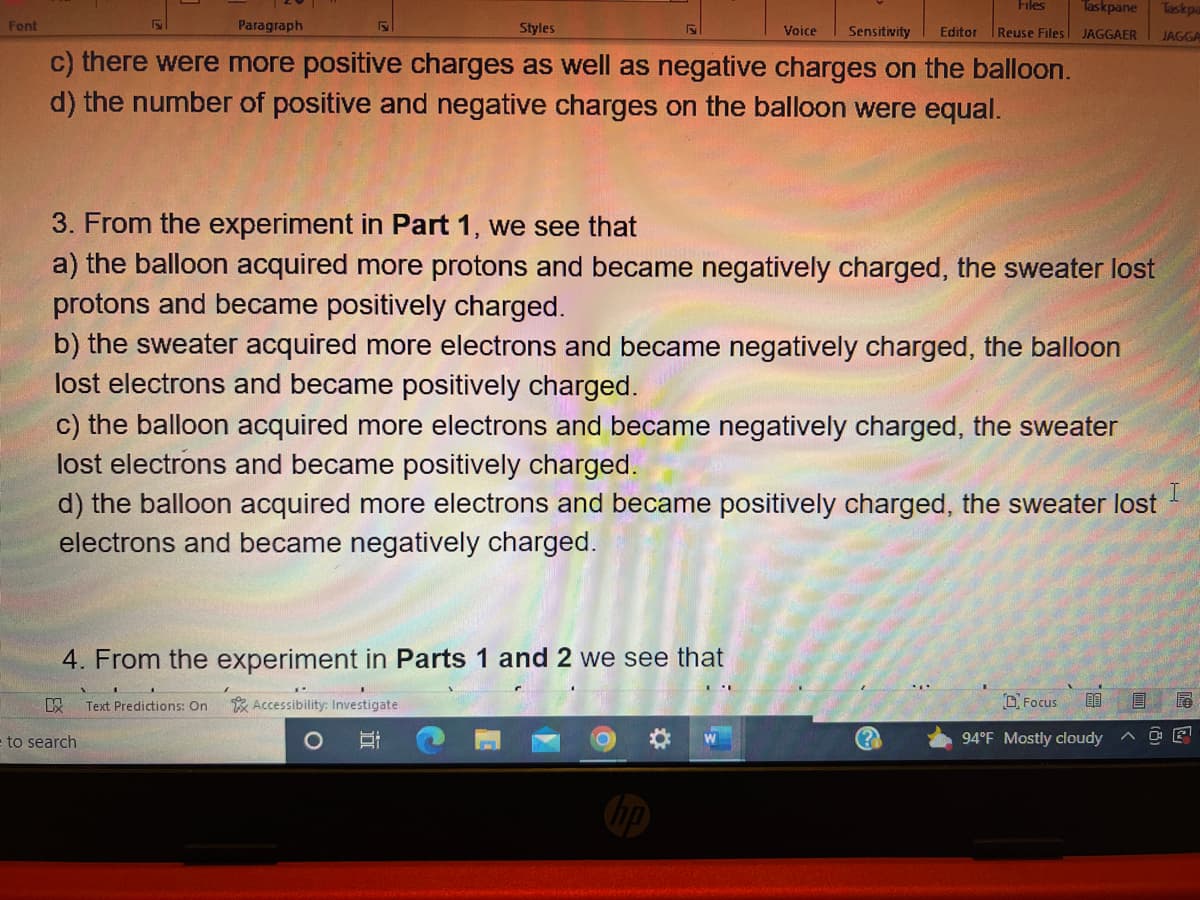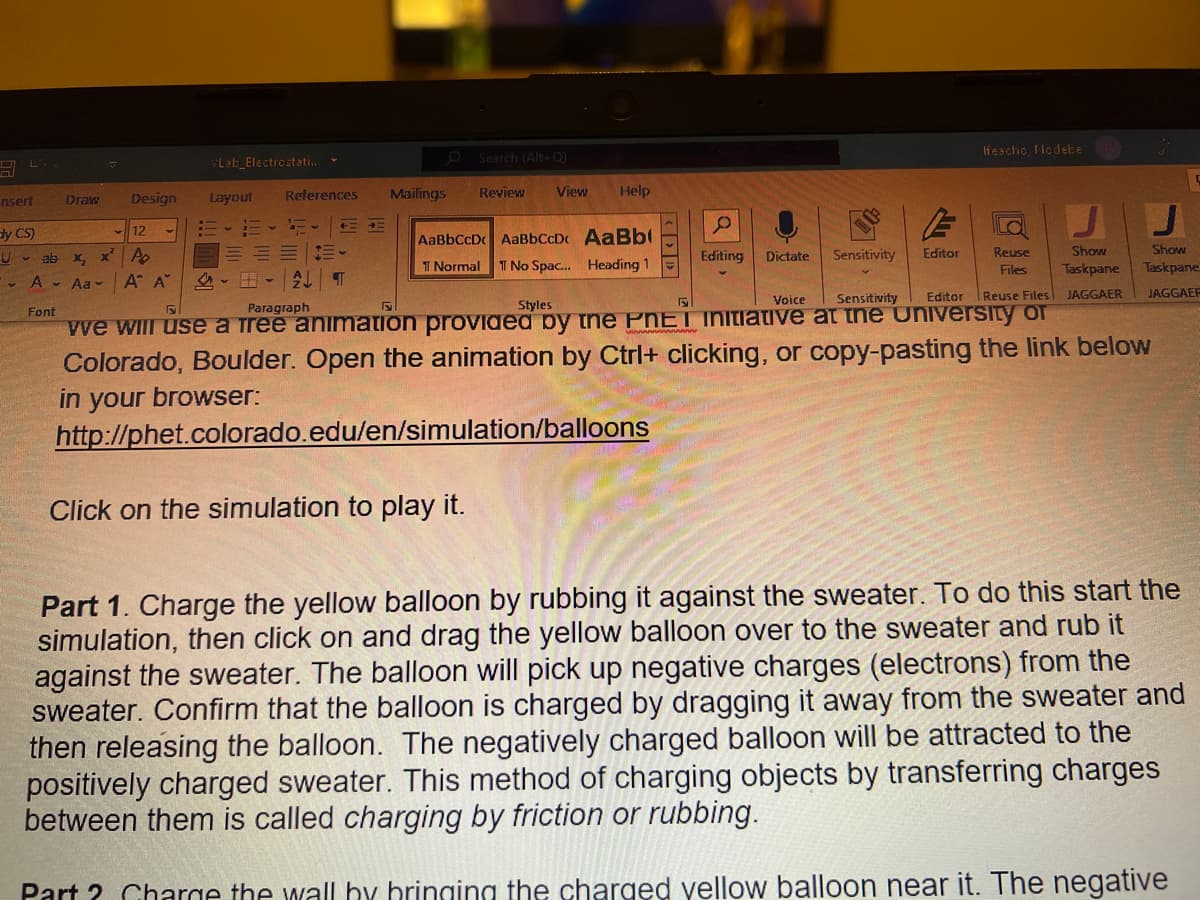3. From the experiment in Part 1, we see that a) the balloon acquired more protons and became negatively charged, the sweater lost protons and became positively charged. b) the sweater acquired more electrons and became negatively charged, the balloon lost electrons and became positively charged. c) the balloon acquired more electrons and became negatively charged, the sweater lost electrons and became positively charged. I d) the balloon acquired more electrons and became positively charged, the sweater lost electrons and became negatively charged.
3. From the experiment in Part 1, we see that a) the balloon acquired more protons and became negatively charged, the sweater lost protons and became positively charged. b) the sweater acquired more electrons and became negatively charged, the balloon lost electrons and became positively charged. c) the balloon acquired more electrons and became negatively charged, the sweater lost electrons and became positively charged. I d) the balloon acquired more electrons and became positively charged, the sweater lost electrons and became negatively charged.
Chapter8: Electromagnetism And Em Waves
Section: Chapter Questions
Problem 9Q
Related questions
Question
3

Transcribed Image Text:Font
Paragraph
Styles
Voice Sensitivity
c) there were more positive charges as well as negative charges on the balloon.
d) the number of positive and negative charges on the balloon were equal.
3. From the experiment in Part 1, we see that
a) the balloon acquired more protons and became negatively charged, the sweater lost
protons and became positively charged.
b) the sweater acquired more electrons and became negatively charged, the balloon
lost electrons and became positively charged.
c) the balloon acquired more electrons and became negatively charged, the sweater
lost electrons and became positively charged.
I
d) the balloon acquired more electrons and became positively charged, the sweater lost
electrons and became negatively charged.
4. From the experiment in Parts 1 and 2 we see that
KX Text Predictions: On
Accessibility: Investigate
E
Files Taskpane
Taskpa
Editor Reuse Files JAGGAER JAGGA
to search
O
(?)
89
94°F Mostly cloudy
Focus
E

Transcribed Image Text:nsert
dy CS)
C-
Draw
Design
12
x² Po
ab
x₂
A - Aa-
Font
A A
Lab Electrostati..
Layout
References
~
ALT
Mailings
√
Search (Alt+Q)
Review
View Help
AaBbCcDc | AaBbCcD. AaBb
T Normal TT No Spac... Heading 1
O
Editing
Dictate
Voice
Sensitivity
Editor
Ifeacho, Nodebe
5
Paragraph
Sensitivity
Styles
Editor
JAGGAER
Reuse Files
vve will use a free animation provided by the PNEI initiative at the University of
Colorado, Boulder. Open the animation by Ctrl+ clicking, or copy-pasting the link below
in your browser:
http://phet.colorado.edu/en/simulation/balloons
Click on the simulation to play it.
B
Show
Reuse
Show
Files Taskpane Taskpane
JAGGAEF
5
Part 1. Charge the yellow balloon by rubbing it against the sweater. To do this start the
simulation, then click on and drag the yellow balloon over to the sweater and rub it
against the sweater. The balloon will pick up negative charges (electrons) from the
sweater. Confirm that the balloon is charged by dragging it away from the sweater and
then releasing the balloon. The negatively charged balloon will be attracted to the
positively charged sweater. This method of charging objects by transferring charges
between them is called charging by friction or rubbing.
Part? Charge the wall by bringing the charged yellow balloon near it. The negative
Expert Solution
This question has been solved!
Explore an expertly crafted, step-by-step solution for a thorough understanding of key concepts.
Step by step
Solved in 2 steps

Knowledge Booster
Learn more about
Need a deep-dive on the concept behind this application? Look no further. Learn more about this topic, physics and related others by exploring similar questions and additional content below.Recommended textbooks for you


University Physics Volume 3
Physics
ISBN:
9781938168185
Author:
William Moebs, Jeff Sanny
Publisher:
OpenStax

College Physics
Physics
ISBN:
9781938168000
Author:
Paul Peter Urone, Roger Hinrichs
Publisher:
OpenStax College


University Physics Volume 3
Physics
ISBN:
9781938168185
Author:
William Moebs, Jeff Sanny
Publisher:
OpenStax

College Physics
Physics
ISBN:
9781938168000
Author:
Paul Peter Urone, Roger Hinrichs
Publisher:
OpenStax College